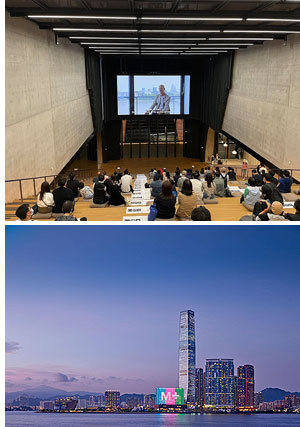Far more than a Museum
by Virginia Fanin
M+ is one of the world’s largest Museums of modern and contemporary art and visual culture, situated in the cultural district of West Kowloon, Hong Kong.
 Suhanya Raffell, Director of the Museum, explains that the choice of name is due to the fact that the combination of digital, works of art, technology and material objects has brought to life something that is much more than a museum.
Suhanya Raffell, Director of the Museum, explains that the choice of name is due to the fact that the combination of digital, works of art, technology and material objects has brought to life something that is much more than a museum.
The building, designed by Herzog & de Meuron in collaboration with TFP Farrells and Arup, looks like an upturned T: the base, measuring 17,000 square metres, is devoted to exhibition space, whilst the tower contains offices, the research centre, storerooms, restaurants, bars, the Learning Hub and a lot more; all in all, there are 18 floors entirely devoted to art.
M+ consists of 33 galleries, three cinemas seating respectively 40, 60 and 180, the Mediathèque, the Grand Stair, the learning centre and a roof garden overlooking Victoria Harbour, which encourages visitors to take a moment for themselves and reflect on the artistic experience they have just had.
The façade is completely covered with LED for the projection of moving images, thus allowing visitors or passers-by to enjoy just a glimpse of the numerous works inside.
The Museum tries to be as sustainable as possible, adhering to the environmental evaluation scheme BEAM Plus, whilst during the whole design process, the ISBD (Integrated Sustainable Building Design) approach was followed.
Inside the Museum four permanent collections may be visited:
-
M+ Collection combines design, architecture, moving images and visual art works;
-
M+ Sigg is one of the largest collections of contemporary Chinese art in the world;
-
M+ Library Special Collection proposes printed material as a specific artistic instrument;
-
M+ Collection Archives brings together important documents devoted to creative processes.
Whilst the three cinemas will open to the public during the month of June 2022, the Mediathèque and the Grand Stair are already in operation.
You will be wondering, as I did before seeing the photos, exactly what is meant by the “Grand Stair”?
It is literally a great wooden staircase where visitors can sit down and enjoy the works programmed such as videos or moving images.
M+ is also committed to involving visitors of all ages, through the Learning Hub, where it is possible to attend conferences, performances, pop-up events and workshops.
The M+ shop is the perfect place for those who wish to take home a reminder of the experience, offering a wealth of various types of souvenir: stationery, books, clothing, objects for the home, including eco-sustainable ones such as drinking bottles or canvas shopping bags.
The Museum offers a choice of eating places for all tastes and budgets: Mosu Hong Kong is characterised by Korean cuisine, ADD+, rather than a meal, offers an authentic culinary experience, whilst for a snack but with an artistic vein to it, there is CURATOR Creative Café where customers can transform their latte or tea into a colourful design thanks to the milk printer, and lastly, for M+ members and customers, the M+ lounge is available.
The Museum had already managed to create a strong link to the local community during the building phase, and also during the pandemic, thanks to digital technology.
M+ is extremely active and interactive on social media, particularly Instagram, where it very often publishes surveys, information on future events, video interviews with artists, works and curious anecdotes.
On the official website, instead, the online magazine can be browsed free of charge, as well as the section devoted to the collections where, sitting on the sofa in their own homes, the user can search through thousands of art works, almost as if they were inside the M+.
With regard to “in their own home”, the Museum is closed at the moment due to new Covid restrictions, but those interested can take part in all the events, including those on the Grand Stair, by enrolling in the webinars.
In conclusion, it is important to point out that amongst the over 6,000 art works exhibited in the Museum, most come from Asia and those created by artists from other continents are all in one way or another linked to Asia.
This is because - as Raffell explains - “We do not want M+ to become a footnote to someone else’s page. We want to be the main story and we tell this story from our own country”.